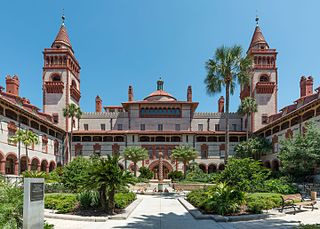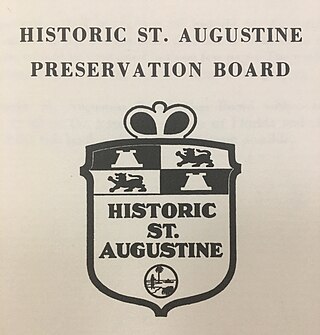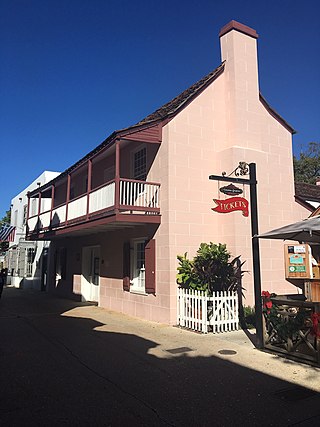
St. Augustine is a city in and the county seat of St. Johns County located 40 miles south of downtown Jacksonville. The city is on the Atlantic coast of northeastern Florida. Founded in 1565 by Spanish explorers, it is the oldest continuously inhabited European-established settlement in what is now the contiguous United States.

Avilés is a town in Asturias, Spain. Avilés is, along with Oviedo and Gijón, one of the main cities in the Principality of Asturias.

The Hotel Ponce de Leon, also known as The Ponce, was a luxury hotel in St. Augustine, Florida, built by millionaire developer and Standard Oil co-founder Henry M. Flagler. Built between 1885–1887, the winter resort opened in January 1888. The hotel was designed in the Spanish Renaissance Revival style as the first major project of the New York architecture firm Carrère & Hastings, which gained world renown for more than 600 projects, including the House and Senate Office Buildings flanking the US Capitol. Their final project was the New York Public Library.

The Oldest Wooden School House is a wooden structure located at 14 St. George Street in St. Augustine, Florida near the city gate. It is touted as being the oldest wooden school building in the United States. The exact date of construction is unknown, but it first appears on tax records in 1716. There are no extant wooden buildings in St. Augustine built prior to 1702 when the British burned the city. The oldest schoolhouse still standing in the United States is the Voorlezer's House built prior to 1696 and located in Historic Richmondtown in Staten Island, New York.

Lincolnville Historic District is a neighborhood in St. Augustine, Florida established by freedmen following the American Civil War and located on the southwest peninsula of the "nation's oldest city." It was designated as an historic district in 1991 and listed on the National Register of Historic Places. Originally recorded with 548 contributing buildings, the district is bounded by Cedar, Riberia, Cerro and Washington streets and DeSoto Place.

The González–Álvarez House, also known as The Oldest House, is a historic house museum at 14 St. Francis Street in St. Augustine, Florida. With a construction history dating to about 1723, it is believed to be the oldest surviving house in St. Augustine. It is also an important example of St. Augustine's Spanish colonial architectural style, with later modifications by English owners. It was designated a U.S. National Historic Landmark in 1970. The house is now owned by the St. Augustine Historical Society and is open for public tours as part of the Oldest House Museum Complex. Evidence can be seen of the Spanish, British, and American occupations of St. Augustine.

The Rodriguez-Avero-Sanchez House is a historic home in St. Augustine, Florida. It is located at 52 St. George Street. It was built in 1762. On April 16, 1971, it was added to the U.S. National Register of Historic Places.

Ximenez-Fatio House Museum is one of the best-preserved and most authentic Second Spanish Period (1783-1821) residential buildings in St. Augustine, Florida. In 1973, it was added to the National Register of Historic Places. It was designated a Florida Heritage Landmark in 2012.

The St. Augustine movement was a part of the wider Civil Rights Movement, taking place in St. Augustine, Florida from 1963 to 1964. It was a major event in the city's long history and had a role in the passage of the Civil Rights Act of 1964.

Charles T. Meide Jr., known as Chuck Meide, is an underwater and maritime archaeologist and currently the Director of LAMP, the research arm of the St. Augustine Lighthouse & Maritime Museum located in St. Augustine, Florida. Meide, of Syrian descent on his father's side, was born in Jacksonville, Florida, and raised in the adjacent coastal town of Atlantic Beach. He earned BA and MA degrees in Anthropology with a focus in underwater archaeology in 1993 and 2001 from Florida State University, where he studied under George R. Fischer, and undertook Ph.D. studies in Historical Archaeology at the College of William and Mary starting the following year.

Athalia Ponsell Lindsley was an American model, Broadway dancer, political activist and television personality on the show Winner Take All.
St. Augustine, Florida, the oldest continuously occupied settlement of European origin in the continental United States, was founded in 1565 by Spanish admiral Pedro Menéndez de Avilés. The Spanish Crown issued an asiento to Menéndez, signed by King Philip II on March 20, 1565, granting him various titles, including that of adelantado of Florida, and expansive privileges to exploit the lands in the vast territory of Spanish Florida, called La Florida by the Spaniards. This contract directed Menéndez to explore the region's Atlantic coast and report on its features, with the object of finding a suitable location to establish a permanent colony from which the Spanish treasure fleet could be defended and Spain's claimed territories in North America protected against incursions by other European powers.

The González-Jones House is a historic home built during the First Spanish Period (1565–1763) in Saint Augustine, Florida. It is located at 56 Marine Street, one block north of the González–Alvarez House and the Saint Francis Barracks. This neighborhood includes nine colonial structures that survive in clusters along Marine and Saint Francis Streets. These buildings are all assumed to have been built after 1702, when the city was destroyed during a British siege.
The St. Augustine Historical Society (SAHS) is a membership organization committed to the preservation and interpretation of historically significant structures, artifacts, and documentary materials related to St. Augustine, Florida. Formally organized on New Years Day 1883, SAHS is the oldest continuously operating museum and historical society in Florida. In 1899, the society purchased the Vedder Museum on Bay Street where it exhibited historical and scientific curiosities until losing its holdings in the Saint Augustine Fire of 1914. In 1920, SAHS successfully lobbied for federal restoration of Fort Matanzas, and in 1965, it played a significant role in the restoration of numerous historic sites in preparation for the St. Augustine quadricentennial.

The Historic St. Augustine Preservation Board (HSAPB) was a state agency in Florida that participated in the restoration and preservation of historic buildings in St. Augustine, Florida from 1959 to 1997. Created in 1959 by Governor LeRoy Collins, the agency acquired, restored, and preserved historic structures in St. Augustine until its abolishment by the State of Florida in June 1997.

The Sánchez de Ortigosa House is located at 60 St. George Street, St. Augustine, Florida. It is a reconstruction of a home dating from the First Spanish Period (1565-1763) that stood on this site.

The De Mesa-Sánchez House is located at 23 St. George Street in St. Augustine, Florida. It is a restoration of a home dating back to East Florida's First Spanish Period.

The Pellicer-De Burgo House is located at 53 St. George Street in St. Augustine, Florida. It is a reconstruction of two connected houses built during the British Period (1763-1783) of East Florida.

The Cubo Line was part of the defense system built by the Spanish to protect the presidio of St. Augustine in the territory of Spanish Florida during the early years of the 18th century.

The Paredes-Dodge House is located at 54 St. George Street in St. Augustine, Florida. The one and a half story structure was built between 1803 and 1813, and is one of the only surviving colonial structures in St. Augustine.
































